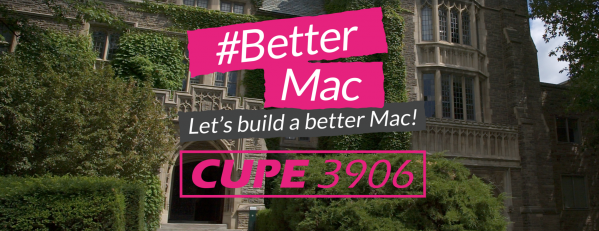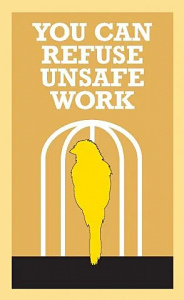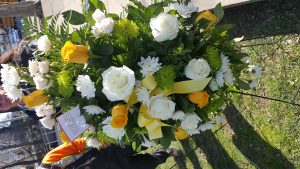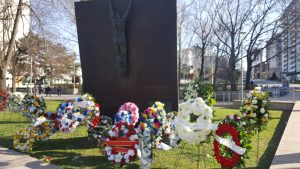An overview of health and safety at CUPE 3906
Health and safety is an essential part of our union’s work. CUPE 3906 members face a wide range of hazards at work. We provide and connect members to tools, resources and training that help them stay safe and empower them to improve conditions at their work and broader society. We also conduct research on current and emerging health and safety hazards. For more information on health and safety activism from our national union (CUPE National), please click here.
At the local level (CUPE 3906), our Health and Safety Officer is an elective member of the executive committee and is primarily responsible for:
-
Safeguarding the occupational health and safety of the membership by being available to members as a resource person and by using their knowledge and training to discover and improve hazardous situations and practices.
-
Reviewing and preparing recommended revisions for the clauses in the Collective Agreement pertaining to the membership’s occupational health and safety, in order to continually improve the quality of the worker’s environment; and
-
Serving on the University Central Occupational Health and Safety Committee.
As workers, we have the right to KNOW (about hazards), PARTICIPATE (in improving the health and safety of our workplaces), and REFUSE (unsafe work without reprisal). We ask:
-
Do you KNOW all your workplace hazards? Your supervisor should know and communicate them to you through workplace specific training. Let the health and safety officer (healthandsafety@cupe3906.org) know if you have any concerns.
-
How do you PARTICIPATE in improving health and safety at work? Do the following:
-
-
If you see or experience something unsafe: First, tell your supervisor. Then, fill out an incident report. Next, consider letting the Health and Safety Officer (healthandsafety@cupe3906.org) and University Health and Safety (UHS) know.
-
-
-
If you think there’s a root cause to the unsafe issue, bring it to the co-chair of your Joint Health and Safety Committee (JHSC). See the membership list here. If you don’t know what area you work in, ask your supervisor and/or ask the Health and Safety Officer (healthandsafety@cupe3906.org)
-
-
-
Want to participate further? Join your JHSC (details as follows) to organize and advocate for changes that you want to see to your workplace! Contact the Health and Safety Officer (healthandsafety@cupe3906.org).
-
-
Do you feel unsafe working? You have the RIGHT TO REFUSE unsafe work. Notify your supervisor immediately. Then contact the Health and Safety Officer (healthandsafety@cupe3906.org) and University Health and Safety (UHS).
Want to PARTICIPTE? Join your Joint Health and Safety Committee (JHSC)
The Health and Safety Officer coordinates the appointment of CUPE 3906 member representation on twenty seven JHSCs at McMaster University. Each JHSC represents areas where work is done for a faculty (e.g., the faculty of Engineering, Science, and Arts have their own JHSCs) or in a specific building (e.g., the McMaster Automotive Resource Centre (MARC) building on Longwood has their own JHSC). CUPE 3906 members can participate in the JHSC where they work. NOTE: work done remotely for a faculty or building is still under the scope of the associated JHSC.
All CUPE 3906 JHSC representative positions are compensated by the Employer under the terms of the Occupational Health Safety Act. You are compensated for the workers’ prep meeting, the faculty/building JHSC meeting, and any workplace inspections and investigations you perform. The payment form is available here.
The responsibilities of CUPE 3906 JHSC representatives are that they attend JHSC meetings and “conduct regular inspections of all McMaster work areas to help better identify any safety-related issues that need to be addressed. JHSCs also make recommendations to Senior Management regarding the identification and control of hazards. These recommendations may include building improvements, procedure implementation, training requirements, policies and programs.” CUPE 3906 JHSC representatives should report back to the membership, when possible. This is facilitated through regularly hosted Health and Safety committee meetings by the Health and Safety Officer (healthandsafety@cupe3906.org).
Under our Collective Agreements and the Occupational Health and Safety Act, we are entitled to representatives from each of our three units (Unit 1- TAs/RA-in-lieu, Unit 2- Sessionals, Unit 3- Postdocs) in each of the areas listed below. If you are interested in joining a JHSC, please contact Anastasia (healthandsafety@cupe3906.org) and fill in the CUPE 3906 JHSC nomination form.
|
JHSC Area |
Building/s (address provided if not located at 1280 Main St. W., Hamilton, ON) |
|
Administration |
1MUSC, GH, Alumni Hall, President’s Residence, Student Wellness (PGCLL) |
|
Arts |
TSH, KTH, CNH, LRWH, UH |
|
Campus Services |
1All buildings (custodial closets, penthouses, mechanical rooms), all property (grounds, parking lots, paths, roads) |
|
Communications Research Laboratory |
Communications Research Laboratory |
|
David Braley Health Sciences Centre |
David Braley Health Science Centre (100 Main St W Hamilton) |
|
DeGroote School of Business |
MDSB |
|
Engineering |
JHE2, ETB2, ABB2, BSB2, ITB, TAB2, ADL, GSB2, |
|
Hamilton General |
Hamilton General Hospital (237 Barton St E, Hamilton) |
|
Health Sciences |
HSC |
|
Hospitality Services |
1 |
|
Housing and Conference Services |
1 |
|
Institute of Applied Health Sciences |
IAHS |
|
Ivor Wynne Centre/David Braley Athletic Centre |
IWC, DBAC |
|
Juravinski |
Juravinski Hospital (711 Concession St, Hamilton, ON) |
|
Libraries and Museum of Art |
1 |
|
Longwood |
McMaster Innovation Park (175 Longwood Rd S Suite 101A, Hamilton, ON) including: Atrium@MIP, CanmetMATERIALS, Biomedical Engineering and Advanced Manufacturing (BEAM) project centre |
|
MARC |
McMaster Automotive Resource Centre (200 Longwood Rd S, Hamilton, ON) |
|
McIARS |
Nuclear Research Building, Nuclear Reactor, TAB2, HP Annex |
|
MDCL |
MDCL |
|
Niagara Regional Campus |
Niagara Regional Campus (1812 Sir Isaac Brock Way St. Catharines, ON) |
|
One James North |
One James North (1 James St. N., Hamilton, ON) |
|
Ron Joyce Centre – DeGroote School of Business |
Ron Joyce Centre (4350 S Service Rd, Burlington, ON) |
|
Science |
LSB, PB, ETB2, JHE2, ABB2, BSB2, GSB2, HH |
|
St. Joseph’s |
St. Joseph’s Healthcare Hamilton (50 Charlton Ave E, Hamilton, ON) |
|
St. Joseph’s Centre for Mountain Health |
St Joseph’s Centre For Mountain Health Services (100 West 5th Street, Hamilton ON) |
|
Stonechurch |
Stonechurch Family Health Centre (1475 Upper Ottawa St, Hamilton ON) |
|
Waterloo Regional Campus |
Waterloo Regional Campus (10b Victoria St S, Kitchener, ON) |
|
UTS |
1 |
|
1 The Local is entitled to representation in this area but members do not typically work here. 2 Portions of the building are shared by multiple JHSC areas |
|
Health and safety policies and procedures at McMaster University:
-
There are many Risk Management Manuals (RMMs) at McMaster University to manage risks associated to occupational hazards. For example:
-
-
Going on a field trip, research activity or placement that is sanctioned by McMaster University? See RMM 801
-
-
-
Unaware of the risks associated with poor ergonomic design of workstations and work practices? See RMM 405
-
-
-
Curious about the maintenance, assessment and control of indoor air quality? See RMM 400
-
-
-
Know what to do in the case of a fire emergency? If not, see RMM 1201.
-
-
Do you work in a lab environment? Your supervisor must provide you with specific training, however, general lab safety information can be found here.
-
AED locations across campus
-
Are you working remotely at a home workstation? You should complete this checklist.
-
A reminder to disconnect from work; McMaster University has a policy concerning this.
External resources for CUPE 3906 members:
-
Occupational mental health guidelines: remember, work shouldn’t make you want to cry!
-
The employer has the duty to accommodate! “Every human rights law in Canada protects workers from discrimination at work, including disability-based discrimination. Discrimination could occur any time that a workplace rule, job requirement, policy, or practice results in a barrier for a worker with a disability”
-
The right to refuse unsafe work fact sheet
-
New and young workers health and safety at work fact sheet
-
Examples of posters that can be distributed in your workplace (be sure to contact the Health and Safety officer if distributing):
-
-
Wear a mask poster
-
-
-
New and young workers poster
-
-
-
Office ergonomics to prevent MSD poster
-
Health and safety training opportunities
The Local is committed to facilitating and supporting health and safety education. Feel passionate about health and safety and want to learn more? Here’s how:
-
Free first aid training! We would like to remind you that Free First Aid Training is a benefit guaranteed under your Collective Agreement and available to all CUPE 3906 members. This a Standard Red Cross certificate course, offered on a number of dates this spring through Athletics and Recreation (dates listed on the Athletics and Rec website). You will need to attend both days in order to receive the certificate.
-
Health and Safety training through CUPE National.
-
CUPE conferences, workshops, and other education opportunities.
-
The above not sufficient? Contact the Health and Safety Officer (healthandsafety@cupe3906.org), let them know what you want to learn more about.
The Day of Mourning (April 28)
From the Workers Health and Safety Centre:
Workers are killed by workplace hazards every day. Every year, hundreds of thousands more suffer injury or illness because of their working conditions. They are not forgotten.
April 28 is our National Day of Mourning to remember workers who have suffered work-related disability, disease and death. The Canadian Labour Congress first declared the Day in 1986. More than 100 countries now observe the Day too.
Unions, labour councils, families and community partners who gather annually on April 28 to mourn these losses also vow to prevent further suffering. They follow with action in the workplace and community pressing for work that promotes dignity and health.
On April 28
-
attend a Day of Mourning event in your community
-
encourage others to attend an event
-
draft a message for your organization’s publication or web site
-
use digital tools to create online communities, posting meaningful photos and messages
-
update your health and safety knowledge through training and webinars
-
work with local media to promote and cover the Day’s significance and events
-
convince employers and public institutions to among other things lower flags to half-mast
-
work with other interested groups to host related events.
On every day
-
educate others about health and safety rights, responsibilities and prevention measures
-
insist on effective workplace prevention programs developed with full worker participation
-
insist on training that supports the identification, assessment and control of workplace hazards
-
encourage local media to report on health, safety and environmental issues
-
press elected officials to support stronger regulations and better enforcement of existing laws
-
create monuments to promote public awareness of workplace health and safety
-
host events with similar objectives in mind.
If you have any questions about our health and safety committee, please email Anastasia (health and safety officer).
Photos from Day of Mourning Ceremony in Hamilton, April 2022. Pictures are of (L-R) K. Morrison, A. Soukhov, M.E. Campbell, and C. Fairweather




